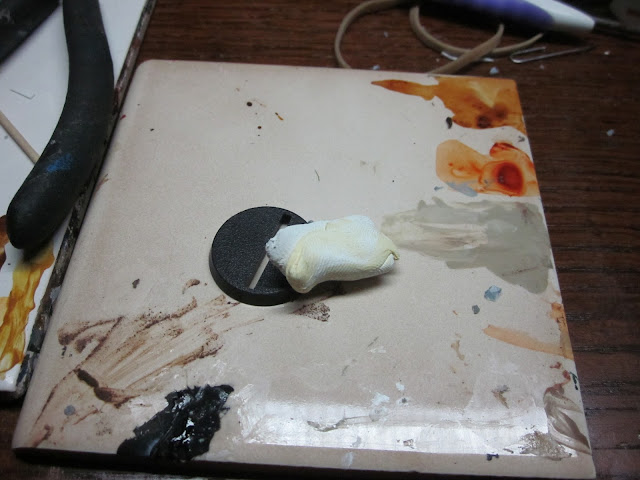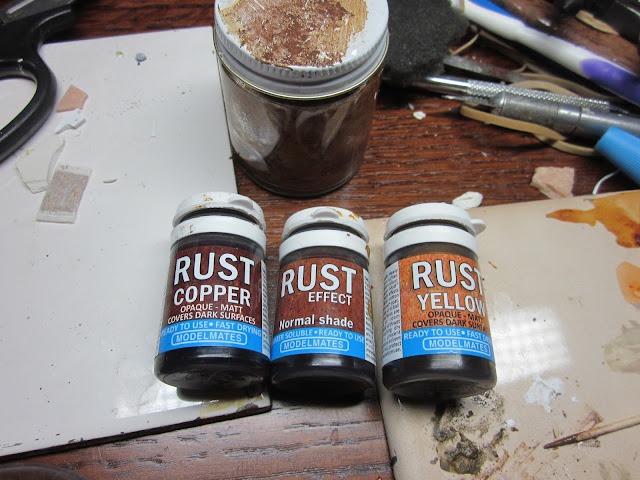So getting this posted took a bit longer than I hoped. Ah well.
Let's get right in to it, shall we?
I just started with a normal, regular slottabase, and added some milliput.
Shaped with a knife (just 2 intersecting lines, looks like the Smash Bros logo) and then added some texture with rock and scrap broken sculpey. Let it dry a bit before doing that, so you don't smush the design. The lines aren't, I don't think, perfectly perpendicular, which doesn't matter in the slightest. We talked about this, remember? Let it dry (3 or so hours?)
Sides sanded flush (or close enough to it.

Hole drilled, roughed up a bit with an x-acto knife.
Adding a little broken-off bolt like I talked about last time. Filed down the end of the paperclip (I'd used wire snips, and they tend to leave tented edges, I wanted it to look more like a bolt), tested fit for depth and then bent the clip using the hole as a fulcrum. With pliers, bent the wire to ~90 degrees, and clipped it. Easy matter after that to glue it into place.
 Primer coat. I usually use Vallejo primers because they're amazing and run perfectly thru an airbrush, but I don't have a respirator right now so I just spray-primed it outside. Rust-Oleum camouflage black (it's super-matte) with a light mist of Tamiya surface primer. I usually prime like this (white over black, that is) to help realize zenithal highlighting, but in this case, it's just to show detail and help paint stick.
Primer coat. I usually use Vallejo primers because they're amazing and run perfectly thru an airbrush, but I don't have a respirator right now so I just spray-primed it outside. Rust-Oleum camouflage black (it's super-matte) with a light mist of Tamiya surface primer. I usually prime like this (white over black, that is) to help realize zenithal highlighting, but in this case, it's just to show detail and help paint stick.
Beginning to paint. For my basecoat, I use a shitty brush (for a base, you pretty much never need to break out your good brushes). Also, shot of wet palette before painting the base (OK, the grey base color is in there, bottom left).

I just used a couple old brushes, clipped down, to stipple the base. If you're going for fast tabletop, you can finish painting here (save for the metal bit), painting to this point was maybe 10 minutes, including taking pictures. But if you want something a bit punchier, follow along.
 Pigment powders are fun as hell, and the best friend of anyone doing bases. All these are sequential, but it's hard to state how incomplete this all is. I dab pigment on, add more, change colors, use it with water to form a pin wash of sorts, etc...Add pure white highlights and then buff it down...This isn't really finished, because I keep adding pigment as I go, whenever I feel like it's needed. It's kind of addictive, honestly.
Pigment powders are fun as hell, and the best friend of anyone doing bases. All these are sequential, but it's hard to state how incomplete this all is. I dab pigment on, add more, change colors, use it with water to form a pin wash of sorts, etc...Add pure white highlights and then buff it down...This isn't really finished, because I keep adding pigment as I go, whenever I feel like it's needed. It's kind of addictive, honestly.
Working on the metal bit now. It's tiny enough that painting is fairly unnecessary, so I just covered it in homemade rust pigments (with white glue as a binder). You can see that I went further with pigments on the base. Then it's time to add rust!
For good rust quickly, it's hard to beat ModelMates rust. It's hard to get here in the states, but well worth it. Water soluble, dries in a kaleidoscope of rusty oxidized hues, and workable even after dry. Fun as hell to work with, and even when used on a display-level miniature, its realism still holds up. You may have noticed the pencil in the background. If you buy metallic pigments, you're probably getting graphite. Rub the edge of a pencil on a surface and you'll get a dark metallic, very similar to metal peeking thru rust. Powder the lead and use your finger to hit larger surfaces. Works really well, looks realistic, and on larger surfaces, use the tip to draw little lines: they look exactly like scratches on a battered rusty surface.
At this point, I'm essentially done with the base, so I used a thin lacquer pigment fixative. Nothing major, just don't want to push anything around any more.
Remember the utility company's spray paint bits on the sidewalk? Of course you do. I'm prepping for those with some liquid mask. Dab on in random places with a bit of sponge, paint over it, and remove with a pencil eraser or your finger. You get a nice chipped effect that mimics chipped and worn-off paint very well. If you're going for a quicker method, you can just use a color that appears on the base and sponge that over something written. But I'm trying to showcase a lot of techniques here, so I'm using masking fluid.
markings on base. No WIP shots because this was a quick thing: using very thinned paint, I drew what you see here. I then went over those lines with lighter paints. Tried to keep all the paints very thin because I wanted it to be slightly translucent, to mimic the feathered edges of spray paint. Did break out a good brush for this, because it's detail work and I didn't want to cock it up.


After removing the mask. Notice the white glue down there? That's important for the next step.
Stains are neat. And I learned at a young age that white glue dries from the outside in, leaving a film
on top and a ring around the edges (who DIDN'T put white glue on their hands, let it dry, and peel it off?). So I mix white glue, a color wash (Secret Weapon's Baby Poop, in this instance), and water, and make a staining liquid. After a bit on the base (no more than 5-10 minutes, I use a bit of paper towel (rolled into a point) and remove as much liquid as will readily absorb. Let the rest dry, and you get a very nice stain, with tide marks and everything. You can apply this multiple times, overlapping, if you want, for example, an old, well-used alchemist's laboratory, or a dirty, blood-stained torture cellar.
Almost done. Just wanted to add some color modulation and bits of discarded chewing gum.
First of all, I added a very thin wash of Secret Weapon's Soft Body Black to one of the panels to darken it, used a bit more to accentuate the cracks. Not terribly visible, but it makes a difference, especially in real life.
Mixed Payne's Grey with some gel medium for body, and placed a couple blobs down. Highlighted with dark grey, then washed it with Vallejo smoke (great multipurpose color, that). Not all of those steps were recorded, the smoke wash for sure comes after the above images. Were there to be a miniature on this base, I'd have arranged the dots to help draw the eye to the miniature, same with the utility company markings.
And a lot of the stuff on this base was done with a humble toothpick. Applying pin washes to cracks, placing blobs of 'gum,' applying some of the pigments, etc. I use sharpened toothpicks to paint in pupils, too. Buy a box. It's like 250 toothpicks for 2 bucks. One of the best tools out there, bar none.
And the final product:
And a lot of the stuff on this base was done with a humble toothpick. Applying pin washes to cracks, placing blobs of 'gum,' applying some of the pigments, etc. I use sharpened toothpicks to paint in pupils, too. Buy a box. It's like 250 toothpicks for 2 bucks. One of the best tools out there, bar none.
And the final product:
Haven't used dullcote to kill the shine, but this is the finished product. about 1.5 hours of painting, including photos. Sculpting was probably a mere 5 minutes; if you include adding the bolt, 10? Working in bulk, the time doesn't increase as a direct function of amount, because you've already got tools out, colors mixed, among other things. And as a base, you can just add bits as your miniature dries, or whatever. Painting a base like this, so long as you take a moment to plan what you want for it, shouldn't add more than an hour to a miniature's completion time. If you go the simple route (stippled colors, maybe a wash to bring out the detail, and a single detail element), I couldn't imagine it taking more than 20 minutes or so, which can be squeezed into downtime when working on the miniature occupying the base. Here's my wet palette after this (not much painting done, but notice the changes from the 'before' image above.):
Using individual colors is a sucker's game. Even Foundry's triad system can't cover everything, and while using a hundred glazes to blend colors works, it's a lot of effort. If you want to highlight something, mix up a lighter variant of the color, don't just use a new light color. If you make a mistake (which I did multiple times on this base, I started with too cool a grey, I went straight to a straw yellow, etc.), just mix it back down and see where you go from there. If all the colors have a bit of the others in them, chances are your end result will look far more harmonious.
So that's it, I guess, for my first step-by-step tutorial. I hope it helps add some techniques to your toolbox, and to look at things in a different light. I realized just now, as I write this, that I originally intended to put some grass and lichen on the base, coming through the cracks, but it's a bit late for that. Not that I can't do it (they're both easy to do, I'll cover it later), but the base is, to me, 'complete,' and I don't want to fuck that up. Another mistake. What did Bob Ross call them? Happy little accidents? I have at least one an hour when I paint, and even my tabletop miniatures take 3-4 hours. Don't sweat it if something goes wrong. So long as you didn't sand off a miniature's face, you're fine.
Also, I recommended getting a pack of toothpicks. For stuff like this (as well as working with pigment powders), a stippling brush is an invaluable tool as well. Don't buy one. Either buy a cheap-ass round brush, or take a round brush that's pretty much dead, and cut the bristles down to about a quarter inch. Bam. Stippling brush. Cheap, stiff hairs work best for this kind of brush, so boar or synthetic actually makes a better tool than badger or sable. I have a specialized stippling brush or two, but I still use my clipped-down 3-dollar synthetic brush for a good 85% of my purposes.
Next time: I have no idea. I'd like to go over glazes and washes, but we'll see where the future takes us. As the folks at Massive Voodoo say, keep on happy painting! (the MV-team is probably the reason I have this blog, and their tutorials are godlike. If the only thing you get from my site is that link, you're already on your way to becoming a better artist).
PS: I use a LOT of parenthetical clauses. It's a weird habit of mine. Is it distracting, or does it give my writing character? Or something else?





































No comments:
Post a Comment